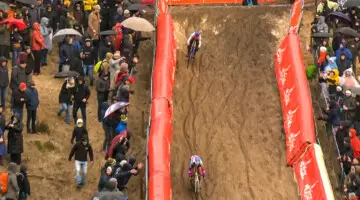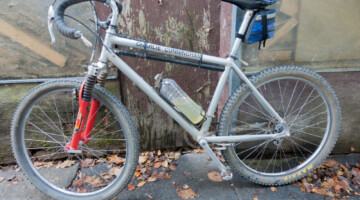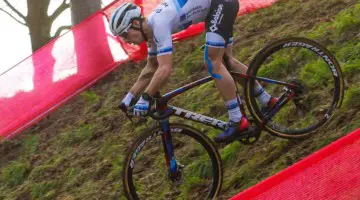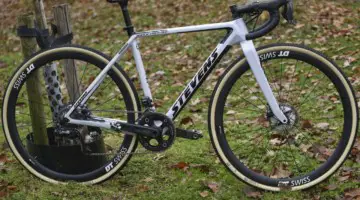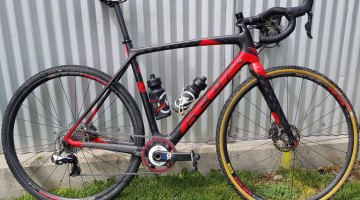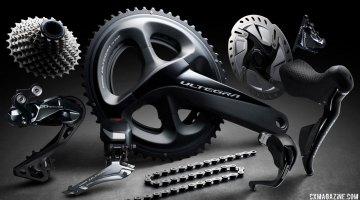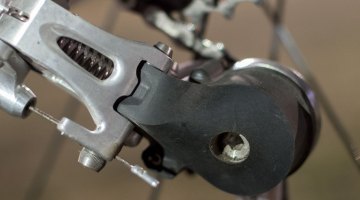by Andrew Yee
The Sea Otter Classic Expo is just a day away, and there’s quite a number of new cyclocross products expected to be unveiled at the Monterey, California event. Several of these new products are disc-brake related, whether it is the highly-anticipated new carbon Redline Conquest (assumed to be disc-ready), or the disc-equipped Airborne Delta cyclocross bike, or TRP’s road brake lever adaptor for hydraulic disc brakes.
Well, the gearheads at Cyclocross Magazine couldn’t wait until Thursday to start geeking out with the new cyclocross gear, and thus we camped out and seized an exclusive early opportunity to preview and ride TRP’s new Parabox hydraulic disc brake system. The Parabox is designed to allow your favorite cable-pull road brake lever/shift lever to actuate a hydraulic disc brake system, not unlike Tim Cannard’s 324 hydraulic brake adaptor system we profiled in December, 2010 (Update: see our updated look at Summit Lab’s 324 Brake Adaptor).
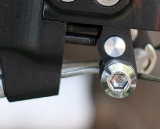
Brake cables pull small levers on the TRP Paradox that in turn push plungers and force hydraulic brake fluid down the lines. © Cyclocross Magazine
The Parabox features a steerer-mounted master cylinder that translates brake cable pull into hydraulic braking power. The unit accomplishes this through two small levers, that when pulled by each brake cable, pushes a plunger in the master cylinder to actuate the fork-mounted front brake hydraulic caliper and the chainstay-mounted (on this Stevens frame) rear hydraulic caliper. Through altering the length of the lever the brake cable pulls, TRP is able to modify and optimize the stopping power of the brake.
The TRP Parabox is designed to work with any road brake lever, whether it’s SRAM DoubleTap, Shimano STI or Di2, Campagnolo Ergopower or even TRP’s own RRL singlespeed lever.
Lance Larrabee, marketing director for TRP Brakes, expects the Parabox to be ready in time for the 2011/2012 cyclocross season both as an aftermarket unit and as OEM equipment on new bikes. Larrabee told Cyclocross Magazine that at the recent Tapei show, the most common question he received from bike company product managers was “when can we get it?”
The Parabox will come complete kit with TRP rotors, calipers, pre-bled hydraulic brake lines and the master cylinder, is expected to retail for $400-500 and will weigh 450 grams.
One common complaint about disc brakes is the added weight. Larrabee figures the Parabox system will add approximately 250g to the bike, or just over a half-pound. This estimate does not include the added weight found on disc-compatible hubs compared to their non-disc versions, but Larrabee believes racers can then ride on lighter rims that offset any additional hub weight as braking surfaces become unnecessary. Is 250g a deal breaker? If part of the attraction of a disc brake-equipped bike is the mud clearance, then 250g seems insignificant compared to possible mud accumulation after just one lap on a muddy course.
The unit sits below the stem and requires about 25mm worth of spacers and a stem that doesn’t have significant negative rise to fit. Technically, you could run the Parabox above the stem if you prefer an aggressive riding position and have a bicycle with a tall head tube.
Update: While the Parabox unit is agnostic to the frame’s rear spacing and just needs a disc-compatible hub, it appears that manufacturers like Stevens are moving to the 135mm mountain bike standard spacing from the 130mm road standard for disc-equipped cyclocross bikes in order to take advantage of the plethora of existing mountain bike hubs and 29er wheels.
Initial Riding Impressions
The Parabox hydraulic caliper mounts on the chainstay of the Stevens disc cyclocross bike. TRP Brakes Parabox Hydraulic Disc Brake Adaptor. © Cyclocross Magazine
I had the first opportunity to ride this early prototype, and I was impressed. The unit actually mimicked the feel of a decent cantilever brake, with perhaps a bit more power than a typical wide-clearance cantilever, but not quite the power of a well-adjusted low-profile cantilever or mini v-brake. For a traditionalist, this can be welcome and safer, as there is not the fly-over-the-handlebar-with-one-finger-braking danger of some mountain bike hydraulic brakes if you’re not used to the power.
But while the disc design, even without additional braking power, adds mud clearance and can make for a lighter rim, rest-assured TRP aims to also harness the additional power and modulation a hydraulic brake can offer. And while pinky-braking may not be the goal, the company is refining the leverage of the cable-pulled lever.
“We’re going to lengthen that cable-pulled lever to increase stopping power,” said Larrabee. “This [prototype] has similar stopping power to a cyclocross cantilever, but our production models will have more.”
If you’re used to hydraulic disc brakes on your mountain bike, the one thing you may notice with such a setup is that unlike with your pure hydraulic levers, the hand position on the road bike lever seems to matter much more. In the drops, pulling at the bottom of the lever Di2, braking power was quite good, and endos and wheel skids were easy. In the hoods, on this early prototype, it took more effort. Keep in mind that these Di2 levers pull 20% more cable than SRAM, Campagnolo or older Shimano levers, which means roughly 20% less power.
While mud clearance and braking power both are potential benefits of such a system, the other benefit is the removal of brake chatter. Without the cable pull-inducing fork flex, you can slam on the front brake to your heart’s content, without the unpredictable chatter found on flexy forks with steerer-mounted cable hangers.
Larrabee believes the Parabox to be a great solution for cyclocrossers who want to uses disc brakes now, but he fully expects companies like SRAM and Shimano to eventually offer a hydraulic brake / shift lever in a few years.
Based on what we saw and rode, the TRP Parabox is an innovative solution that allows you to harness the benefits of disc brakes this season. We’re excited to try the production units and find some real mud for some real-world testing. Stay tuned.
Photo Gallery:










